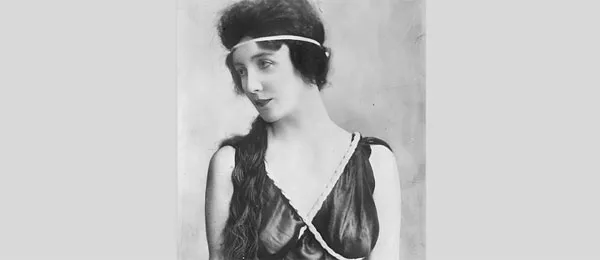Although including nude women in film as often as possible seems to be a current industry standard in Hollywood, it wasn’t always so. The very first instance of female nudity in a non-pornographic film occurred in a 1915 film titled Inspiration — Audrey Munson played a sculptor’s model in a film that would end up buried with the passage of time, along with her bittersweet legacy.
Munson began her career as a model for sculptors — she moved to New York City in 1906 when she was 15 and was “discovered” on the street by a photographer who, enamored by her beauty, employed her. Her career took off, especially after being introduced to famed sculptor Isidor Konti. Her form would eventually come to grace fifteen statues in Manhattan, including the USS Maine Monument at Columbus Circle and the golden statue Civic Fame atop the Manhattan Municipal Building.
In 1915 she moved to California in the wake of her modeling success, landing a job as a sculpture model in a film. Inspiration thwarted censorship attempts by mixing high art with her naked form — the film did not aspire to be like pornographic material (that was just starting to take advantage of the new medium of film), it merely endeavored to render the naked female form as art. She appeared in four silent films altogether, all thought lost (one was recently discovered in a French archive but has not been shown).
Following her success as a actress, Munson moved back to New York in 1919. During the 1920s she began her career as a writer, penning stories for William Randolph Hearst‘s New York Journal American about modeling and the unattainable beauty standards of modernity: “All girls cannot be perfect 36s, with bodies of mystic warmth and plastic marble effect, colored with rose and a dash of flame.”
Munson and her mother lived in with a wealthy doctor, whose wife began to suspect an affair between the doctor and Munson’s mother. She evicted Munson and her mother, but was soon found murdered. Her husband was convicted, jailed, and ended up hanging himself in his cell.
The negative press from his trial and suicide evaporated her career, forcing Munson and her mother to leave the city and move upstate. In 1922 she attempted suicide. Soon after, she was committed to an insane asylum, blamed for a rash of local barns burning down. She was 39, and likely suffering from depression and schizophrenia, extremely stigmatized conditions, especially for women. She spent the rest of her life locked away, dying in 1996 at age 105. She was buried in an anonymous grave in her father’s cemetery plot.
In another article for the New York Journal American, Munson considered what was to become of her as she aged:
“What becomes of the artists’ models? I am wondering if many of my readers have not stood before a masterpiece of lovely sculpture or a remarkable painting of a young girl, her very abandonment of draperies accentuating rather than diminishing her modesty and purity, and asked themselves the question, ‘Where is she now, this model who was so beautiful?’”
She rests in the annals of history and the materiality of stone, her briefly bright legacy obscured by time and unfortunate circumstance.
(via Badass Digest.)








Published: Jun 20, 2012 11:02 am